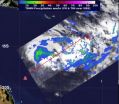(Press-News.org) Salmon are beginning to swim up the Elwha River for the first time in more than a century. But University of Washington marine geologists are watching what's beginning to flow downstream – sediments from the largest dam-removal project ever undertaken.
The 108-foot Elwha Dam was built in 1910, and after decades of debate it was finally dismantled last year. Roughly a third of the 210-foot Glines Canyon Dam still stands, holding back a mountain of silt, sand and gravel.
Removal of the upper dam was halted in January while crews repair a water-treatment plant near Port Angeles that got clogged with leaves and other debris. For engineers, this phase may be the trickiest part of the dam-removal project. For oceanographers, "the best is yet to come," said Charles Nittrouer, a UW professor of oceanography and of Earth and space sciences.
It turns out there is even more sediment than originally thought – about 34 million cubic yards. That's more than 3 million truck loads, enough to bury all of Seattle in a layer almost 3 inches thick.
Aerial photos show sediment starting to fan out around the river's mouth.
"One of the risks of just looking at these beautiful plume pictures is that you really don't know the extent of where that sediment actually ends up," said Andrea Ogston, a UW associate professor of oceanography. "Our focus is looking at what's happening very close to the seabed – how it's going to move, where it's going to get to, what's its ultimate fate."
For the past five years, Ogston and Nittrouer and their students have been studying the sediment around the river mouth, initially with the support of Washington Sea Grant, to understand the condition before the dams' removal. Their current project, funded by the National Science Foundation, is looking for events that could act like a hundred-year storm and bury the sediment deep in the ocean.
The UW researchers have instruments to track particles in the water and record them accumulating on the ocean floor. They are on high alert for a rapid response when the river floods and dislodges the sediment. When that happens, they want to be onsite to record as much data as possible – and perhaps be the first to witness a rare geologic event.
In nature, deep-sea sediment flows triggered by earthquakes or extreme storms can be important for creating oil reserves and other geologic deposits, as a component of the global carbon cycle, and responsible for burying communication cables.
Computer models and the geologic record suggest that when the sediment is in high-enough concentrations, it goes directly to the ocean floor. Instead of the fresh river water floating on top of the seawater, the river water becomes denser than the sea, and the sediment-laden river water plunges below the ocean water.
For the Elwha, that path would take much of the sediment away from the coastline and deep into the Strait of Juan de Fuca.
"A surface plume is very much at the whim of the winds and tides, whereas these underflows are just going down the steepest gradient," Ogston said. "These are two very different mechanisms that would create very different impacts to the seabed."
The dams initially powered a pulp mill and were built unusually close to the ocean – the upper dam is just 13 miles from the river mouth. Their removal provides a unique opportunity to study large river discharges.
"There is an understanding of the general type of flow, and people have predicted that it occurs in rivers, but no one has seen the smoking gun yet," Nittrouer said. "This is a chance to document a 100-year storm. It's really somewhat new territory."
So far there have been dramatic changes to the seabed in the shallows, but few changes below about 20 feet, Ogston said.
Where the sediment ends up is of practical interest. Sediment can make the water murky, creating conditions that make it difficult for salmon to lay eggs, or block light from reaching algae and other life on the ocean floor. On the other hand, the sediment also has positive impacts. Many people hope that removing the dam will help with erosion along the Olympic Coast. The new sediment could accumulate and restore natural beaches on the bluffs near Port Angeles.
A better understanding of sediment transport could also help determine the timing of future dam removals.
"One of the arguments is that rather than having a river that's unacceptable to salmon for many years, you can accelerate the erosion to flush the system. That way you have two or three really bad years instead of two or three pretty bad decades," Nittrouer said. Future projects might be trickier, he added, if the sediments contain pesticides or other chemicals.
Nobody knows when the Elwha's sediment mother lode will begin to shift. A heavy rainfall combined with spring melt could dislodge the heap; if not, next fall and early winter rains will do the job. Either way, the UW marine geologists will be ready to hop in their van, hitch up a boat, and race out to see what happens.
"This is a very exciting time," Ogston said.
INFORMATION:
For more information, contact Ogston at 206-543-0768 or ogston@ocean.washington.edu and Nittrouer at 206-543-5099 or nittroue@ocean.washington.edu. Nittrouer is on travel until the end of March and is best reached via e-mail.
Tracking sediments' fate in largest-ever dam removal
2013-03-08
ELSE PRESS RELEASES FROM THIS DATE:
Researchers discover 'gateway' in nucleus has a second important job no one noticed before
2013-03-08
UAlberta medical researchers and their American colleagues have discovered that the "gateway" known to control the movement of molecules in and out of a cell's nucleus appears to play another critically important role – one no one had noticed until now.
These "gateways" have a second key job in a cell – the ability to control the structure of chromosomes and the DNA linked to those chromosomes. This impacts what genes produce or express. The discovery gives scientists a new way to investigate the triggers for various kinds of disease, says Richard Wozniak, the principal ...
New form of animal communication discovered
2013-03-08
Sniffing, a common behavior in dogs, cats and other animals, has been observed to also serve as a method for rats to communicate—a fundamental discovery that may help scientists identify brain regions critical for interpreting communications cues and what brain malfunctions may cause some complex social disorders.
Researchers have long observed how animals vigorously sniff when they interact, a habit usually passed off as simply smelling each other. But Daniel W. Wesson, PhD, of Case Western Reserve University School of Medicine, whose research is published in Current ...
Is this peptide a key to happiness?
2013-03-08
What makes us happy? Family? Money? Love? How about a peptide?
The neurochemical changes underlying human emotions and social behavior are largely unknown. Now though, for the first time in humans, scientists at UCLA have measured the release of a specific peptide, a neurotransmitter called hypocretin, that greatly increased when subjects were happy but decreased when they were sad.
The finding suggests that boosting hypocretin could elevate both mood and alertness in humans, thus laying the foundation for possible future treatments of psychiatric disorders like ...
U of T engineering breakthrough promises significantly more efficient solar cells
2013-03-08
TORONTO, ON – March 7, 2013: A new technique developed by U of T Engineering Professor Ted Sargent and his research group could lead to significantly more efficient solar cells, according to a recent paper published in the journal Nano Letters.
The paper, "Jointly-tuned plasmonic-excitonic photovoltaics using nanoshells," describes a new technique to improve efficiency in colloidal quantum dot photovoltaics, a technology which already promises inexpensive, more efficient solar cell technology. Quantum dot photovoltaics offers the potential for low-cost, large-area solar ...
Education's protective effect on marriage differs between white and African-American women
2013-03-08
NEW BRUNSWICK, N.J. – Married couples who have attained higher levels of education are less likely to divorce than less-educated couples, but a new study conducted at Rutgers School of Social Work points to significant racial differences.
"African-American women don't seem to enjoy the same degree of protection that education confers on marriage," said Jeounghee Kim, assistant professor at the school. "For white Americans, higher education is related to a lower chance of divorce, and this protective effect of education on marriage increased consistently among the recent ...
Prairie dogs disperse when all close kin have disappeared
2013-03-08
FROSTBURG, MD (March 7, 2013)—Prairie dogs pull up stakes and look for a new place to live when all their close kin have disappeared from their home territory--a striking pattern of dispersal that has not been observed for any other species. This is according to a new study published in Science by behavioral ecologist John Hoogland, Professor at the University of Maryland Center for Environmental Science's Appalachian Laboratory. He has been studying the ecology and social behavior of prairie dogs in national parks in Arizona, South Dakota, and Utah for the last 40 years.
For ...
Drugs targeting blood vessels may be candidates for treating Alzheimer's
2013-03-08
University of British Columbia researchers have successfully normalized the production of blood vessels in the brain of mice with Alzheimer's disease (AD) by immunizing them with amyloid beta, a protein widely associated with the disease.
While AD is typically characterized by a build-up of plaques in the brain, recent research by the UBC team showed a near doubling of blood vessels in the brain of mice and humans with AD.
The new study, published online last week in Scientific Reports, a Nature journal, shows a reduction of brain capillaries in mice immunized with ...
Engineers develop techniques to boost efficiency of cloud computing infrastructure
2013-03-08
Computer scientists at the University of California, San Diego, and Google have developed a novel approach that allows the massive infrastructure powering cloud computing as much as 15 to 20 percent more efficiently. This novel model has already been applied at Google. Researchers presented their findings at the IEEE International Symposium on High Performance Computer Architecture conference Feb. 23 to 27 in China.
Computer scientists looked at a range of Google web services, including Gmail and search. They used a unique approach to develop their model. Their first ...
The future of ion traps
2013-03-08
Recently Science Magazine invited JQI fellow Chris Monroe and Duke Professor Jungsang Kim to speculate on ion trap technology as a scalable option for quantum information processing. The article is highlighted on the cover of this week's issue, which is dedicated to quantum information. The cover portrays a photograph of a surface trap that was fabricated by Sandia National Labs and used to trap ions at JQI and Duke, among other laboratories.
Trapped atomic ions are a promising architecture that satisfies many of the critical requirements for constructing a quantum computer. ...
NASA's TRMM satellite sees Tropical Cyclone 19P form
2013-03-08
NASA's Tropical Rainfall Measuring Mission satellite noticed areas of heavy rainfall in low pressure System 92P hours before it became the nineteenth tropical cyclone of the Southern Pacific Ocean.
NASA's TRMM satellite captured a look at the rainfall rates within low pressure System 92P on March 7 at 0023 UTC (March 6 at 7:23 p.m. EST), just hours before it became Tropical Cyclone 19P (TC 19P). TRMM data indicated that heavy rain was falling at a rate of 2 inches/50 mm per hour around the center of circulation, and that some of the thunderstorms were powerful as they ...


